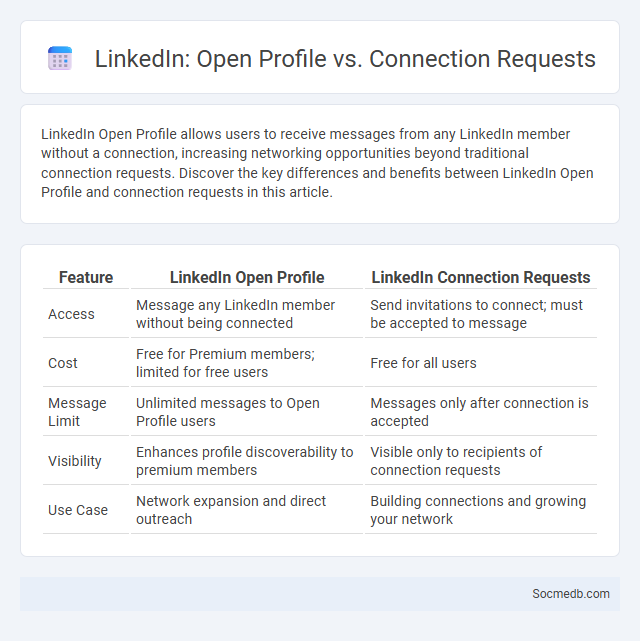
Photo illustration: LinkedIn Open Profile vs Connection Requests
LinkedIn Open Profile allows users to receive messages from any LinkedIn member without a connection, increasing networking opportunities beyond traditional connection requests. Discover the key differences and benefits between LinkedIn Open Profile and connection requests in this article.
Table of Comparison
| Feature | LinkedIn Open Profile | LinkedIn Connection Requests |
|---|---|---|
| Access | Message any LinkedIn member without being connected | Send invitations to connect; must be accepted to message |
| Cost | Free for Premium members; limited for free users | Free for all users |
| Message Limit | Unlimited messages to Open Profile users | Messages only after connection is accepted |
| Visibility | Enhances profile discoverability to premium members | Visible only to recipients of connection requests |
| Use Case | Network expansion and direct outreach | Building connections and growing your network |
Introduction to LinkedIn Networking Options
LinkedIn offers diverse networking options such as connections, groups, and InMail messaging to enhance professional relationships. Users can join industry-specific groups to engage in targeted discussions and expand their network effectively. Advanced features like LinkedIn Premium provide additional tools for personalized outreach and detailed analytics.
What is LinkedIn Open Profile?
LinkedIn Open Profile is a feature that allows any LinkedIn member to contact you for free, even if they are not a connection or part of your network. This feature enhances visibility and networking opportunities by enabling direct messages from all LinkedIn users, bypassing typical InMail restrictions. Open Profile is especially useful for professionals seeking to expand their reach, attract recruiters, and build industry connections.
Understanding LinkedIn Connection Requests
LinkedIn connection requests are essential for building professional networks, enabling users to expand their reach and discover career opportunities. Crafting personalized messages in connection requests increases acceptance rates by demonstrating genuine interest and relevance. Analyzing recipient profiles before sending requests helps tailor communication, fostering stronger professional relationships and enhancing networking effectiveness.
Key Differences Between Open Profile and Connection Requests
Open profiles allow social media users to share content publicly, enabling broader visibility beyond their immediate network, while connection requests require mutual approval, fostering a more controlled and private interaction. Users with open profiles typically gain increased reach and engagement due to unrestricted access, whereas connection requests create exclusive networks, enhancing trust and relevance among contacts. Privacy settings and content exposure fundamentally distinguish these two approaches, impacting user experience and networking strategies on platforms like LinkedIn and Facebook.
Benefits of Using LinkedIn Open Profile
LinkedIn Open Profile enhances networking opportunities by allowing anyone on LinkedIn to send messages without an InMail restriction, increasing engagement and connection potential. It improves visibility for professionals seeking job opportunities or clients, as profiles become accessible for direct communication even outside their immediate network. Open Profile also supports personal branding by enabling seamless interactions with recruiters and industry experts, fostering career growth and business development.
Drawbacks of Open Profile on LinkedIn
An open profile on LinkedIn exposes your professional information to a broader audience, increasing the risk of unsolicited messages and potential privacy breaches. This visibility may attract recruiters and competitors alike, potentially compromising your job security and personal data. Be cautious about what you share to protect your professional reputation and control the access to your network.
Why Choose Connection Requests Over Open Profile?
Connection requests on social media offer a more personalized and deliberate approach to networking, allowing users to build targeted, meaningful relationships by selectively approving contacts. Unlike Open Profile settings, which grant broad access to messaging features without prior approval, connection requests ensure a higher level of trust and engagement between parties. This selectivity helps maintain privacy and fosters genuine interactions critical for professional networking platforms like LinkedIn.
Privacy Considerations: Open Profile vs Connection Requests
Managing your social media privacy involves balancing visibility and control; an open profile allows anyone to view your content, increasing exposure but potentially compromising personal information. Connection requests provide a layer of security by enabling you to approve who accesses your posts, helping to protect your data from unknown or untrusted users. Carefully adjusting privacy settings based on your comfort level ensures your information remains secure while maintaining meaningful online interactions.
Best Practices for Effective LinkedIn Networking
Optimizing LinkedIn networking involves creating a professional, complete profile that highlights key skills, experiences, and achievements to attract relevant connections. Engaging consistently through personalized connection requests, meaningful comments, and sharing industry-related content enhances visibility and credibility. Leveraging LinkedIn's advanced search and groups allows targeting specific professionals and communities for strategic relationship building.
Conclusion: Choosing the Right LinkedIn Networking Method
Selecting the right LinkedIn networking method depends on aligning strategies with professional goals, such as direct messaging for personalized connections or participating in industry groups for broader engagement. Leveraging LinkedIn's tools like LinkedIn Sales Navigator or Alumni Networks can maximize outreach effectiveness and target specific audiences. Consistent interaction and quality content sharing enhance visibility, credibility, and relationship-building on the platform.
 socmedb.com
socmedb.com